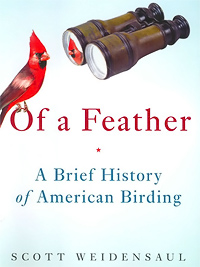Sunday, September 9, 2007
Of a Feather
This weekend I finished Scott Weidensaul's latest book Of a Feather: A Brief History of American Birding. I often find birding difficult to enjoy in print (I'd rather be birding than read about it) and my favorite reading subjects are typically science and natural history. I slugged my way through Mark Obmascik's The Big Year - dreadfully boring, I thought. However, Kenn Kaufman's Kingbird Highway is a notable exception. In Of a Feather, Weidensaul provides a general overview of the history of birding in America. Covered are contributions of early ornithological pioneers like John James Audubon, Alexander Wilson, Bell, Baird, Nuttall and many others with less recognizable names. The evolution of the field guide is reviewed up to Roger Tory Peterson and David Allen Sibley. From shotgun ornithology and collecting bird skins to the first to use optics to view birds and identify them by field marks, the book methodically makes its way to contemporary birding.
For me, though, the most interesting material in Weidensaul's book is found in the final two chapters where he expresses concern over the activity of intense listing. He recalls a birder who chased a particular coveted species who then lost any interest in watching the bird mere seconds after the lifer was ticked. I'm sure many of us have witnessed something similar or perhaps have even done it. I can remember a few times I was at the mercy of another driver or group but wanted to stay to watch birds at a particular spot, but had to abandon the desire because the area had been exhausted of the potential for earning any year birds. At its worst are those who would say you're wasting your time birding at a location if you can't pick up a new species for a list. There's one thing I can say about the type of bird photography I do - it requires me to watch birds for hours at a single spot...even the common ones.
Weidensual writes...
"For many years, I've harbored a growing unease and frustration at the disconnect between the burgeoning enthusiasm for birding and a pervasive apathy about birds themselves, as organisms in their own right, whose protection and preservation should be among our highest priorities."
And later on...
"Can you name a single, concrete action you’ve taken in the past week to better the world for birds? In the last month? The last year? If you had to think about it for more than a moment, then I gently suggest you rededicate yourself do doing more for the creatures on which our hobby is based."
Reading something like this might make birders get a little defensive. I immediately broke into a mental exercise of my contributions. I remembered when I spoke to Middleton City Council nearly a decade ago about the birds of Pheasant Branch Conservancy - creating an awareness of their presence, rich diversity and encouraging their protection – this has always been a priority for me, even on field trips. Though I once emulated the behavior of "spot, tick and run," there has always been a higher sense of duty to give something back to birds. My contribution may be very small compared to many, but I still feel this particular sense of obligation to the feathered ones.
While I don't want this post to initiate some kind of philanthropic scorecard, I'll state that I donate a fair amount of money to conservation groups. I volunteer time as a field trip leader for Madison Audubon and Friends of Pheasant Branch. And while my policy is to never give my photographs away without compensation, I occasionally make exceptions for a few organizations like The Nature Conservancy. All of the proceeds of a DVD titled "Birds of Pheasant Branch Conservancy," which includes my bird photography set to music, go to the Friends of Pheasant Branch. I like to think that my blog helps to create awareness to some degree and I do it completely on my own, expecting nothing but my own enjoyment in return. There's more I do, but all of it pales in comparison to the donations my employer routinely gives to the cause of protecting birds to dozens of organizations throughout the United States.
So, is Weidensaul right? He adds...
"Lists are fine things, as far as they go, but for a lot of birders, the list has become the whole shooting match, the alpha and the omega. It needn't exclude conservation, but for too many birders, it does."
Several months ago I wanted to blog about something, but would have done so purely out of a desire to rant. (But this is what opinionated blogs are for, though, right?) Anyway, when the Class of 2006 Whooping Cranes perished, my first reaction was sorrow followed by the thought I should give Operation Migration money beyond my regular membership fee. So I did. I'm supportive of the Direct Autumn Release program, too, and perhaps, I thought, people are putting their money there, but I confess still being disappointed by the absence of certain names under the "Remembering the Class of 2006" acknowledgement page on OM's website. Where were the names of birders who regularly post to rare bird hotlines and listservs? It made me a little uneasy. The list doesn't include annual memberships and other contributions to OM, but still...I guess I sort of figured the tragedy would earn more of a reaction from even diehard listers. When Whooping Cranes in Wisconsin can be officially counted on a birding list, by the rules, perhaps then these beautiful cranes will garner a little more attention. Listers will gladly tick them. Should they help pay for them now?
Weidensaul has some very important things to say about the listing and sport aspect of birding – it's not all negative. It's a fact that the World Series of Birding has generated millions of dollars for conservation causes. I don't want to be preachy, but I think the last two chapters of his book should be read by every birder. The historical chapters are mildly interesting, a little dry at times, but overall Of a Feather one of the best books about birding I've ever read and recommend it.


















